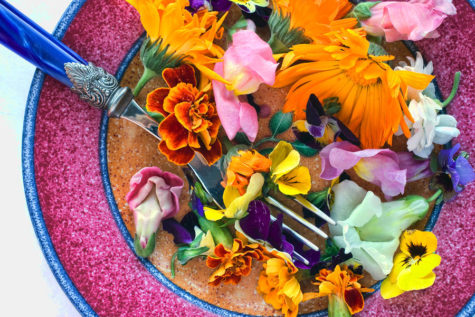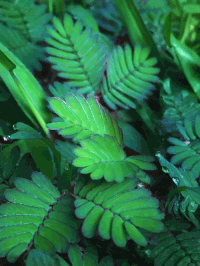Flowers You Can Eat
Here is an extensive but by no means complete listing of edible flowers. I’ve listed them as follows:
- Common name: (botonical name): Flavor – other information.
Please note: While the flowers mentioned in this edible flowers list are edible, other parts of the plants mentioned in this list may be poisonous. Know what you’re eating! Also, be sure that no pesticides of other potentially harmful substances have been applied to the plant. Avoid plants growing along the sides of roads as they may have absorbed toxins from passing traffic. Be sure to read The 10 Commandments of Edible Flowers before experimenting.
A
- Anise (hyssop Agastache foeniculum): Licorice
- Apple (Malus spp.): Floral – Eat in moderation since flowers contain cyanide precursors
- Arugula (Eruca vesicaria sativa): Peppery – once flowers form, the leaves become bitter
B
- Basil (Ocimum basilicum): Herbal
- Bachelor’s button (Centaurea cyanus): Vegetal – petals are edible; the calyx is bitter
- Bee balm (Monarda didyma): Minty, sweet, hot
- Begonias Tuberous (Begonia X tuberosa): citrus-sour – Stems can be used in place of rhubarb. The flowers and stems contain oxalic acid and should not be consumed by individuals suffering from gout, kidney stones, or rheumatism.
- Begonias Wax (Begonia cucullata): – The fleshy leaves and flowers are edible raw or cooked. They can have a slight bitter after taste and if in water most of the time, a hint of swamp in their flavor.
- Borage (Borago officinalis): Cucumber – use sparingly – diuretic effects, combines well with nasturtiums
- Broccoli (Brassica oleracea, Botrytis group): Spicy
C
- Calendula (Calendula officinalis): spicy to bitter, tangy to peppery, sharp taste resembles saffron
- Carnations (Dianthus caryophyllus – aka Dianthus): Sweet – cut petals away from the bitter white base of the flower.
- Canary creeper (Tropaeolum peregrinum): Peppery
- Chamomile (Anthemis nobilis, Chamaemelum noblis): Sweet apple – use in moderation, contains thuaone; ragweed sufferers may be allergic to chamomile
- Chervil (Anthriscus cerefolium): Herbal
- Chicory (Cichorium intybus): Slightly bitter
- Chives (Allium schoenoprasum): Oniony – avoid eating whole flower; taste can be overwhelming
- Chrysanthemum (Chrysanthemum coronarium): Tangy, slightly bitter – Always remove the bitter flower base and use petals only
- Clover (Trifolium species): Sweet, anise-like, licorice – Raw flower heads can be difficult to digest.
- Cornflower (Centaurea cynaus): slightly sweet to spicy, clove-like flavor.
D
- Dame’s Rocket (Hesperis matronalis): bitter – Often mistaken for Phlox. Leaves should be picked before the plant flowers. Seed can be sprouted and added to salads.
- Dandelion (Taraxacum officinale): Sweet, honey-like, slightly bitter – use young flowers, mature flowers become bitter
- Daylily (Hemerocallis spp.): Like sweet lettuce or melon – may act as a diuretic or laxative; eat in moderation. Not to be confused with other types of Lilies which may ontain alkaloids and are NOT edible.
- Dianthus (Dianthus caryophyllus): Sweet, clove – remove the narrow base of the petals (bitter)
- Dill (Anethum graveolens): Herbal
E
- Elderberry (Sambucus canadensis): Sweet – do not wash flowers as it removes much of the flavor
- English daisy (Bellis perennis): Slightly bitter
F
- Fennel (Foeniculum vulgare): Mildly anise
- Fuchsia (Fuchsia X hybrida): Slightly acidic – The berries are also edible.
G
- Garden Sorrel (Rumex acetosa): Tart, lemony
- Garlic chives (Allium tuberosum): Garlicky
- Ginger (Zingiber officinale): Gingery
- Gladiolus (Gladiolus spp): – nondescript flavor, vaguely like lettuce – remove anthers
H
- Hibiscus (Hibiscus rosa-sinensis): Mild citrus, cranberry-like
- Hollyhock (Alcea rosea): Mild nutty
- Honeysuckle (Lonicera japonica): Sweet honey flavor – only the flowers are edible. Berries are highly poisonous – do not eat them!
- Hyssop (Hyssopus officinalis): Strong herbal
I
- Impatiens (Impatiens wallerana): Sweet
- Indian Lotus (Nelumbo nucifera): Floral, Sweet (roots), Nutty (seeds) – Every part is edible. The stamens can be dried and made into a fragrant herbal tea. Seeds are roasted to make puffs called mahkanas. The plant’s roots are ground up to make lotus meal.
J
- Japanese plum (Prunus ‘Mume’): Sweet almond
- Jasmine (Jasminum sambac and J. officinale): Sweet floral
- Johnny-jump-up (Viola tricolor): Slightly minty, wintergreen – petals have little flavor unless the green sepals are included.
L
- Lavender (Lavandula spp.): Strong floral – use sparingly due to intense flavor
- Lemon (Citrus limon): Sweet citrus
- Lemon verbena (Aloysia triphylla): Sweet citrus
- Lilac (Syringa spp.): Very fragramt, slightly bitter. Has a distinct lemony taste with floral, pungent overtones. – The flavor of lilacs varies from plant to plant.
- Linden (Tilia spp.): Sweet, Honey-like – Frequent consumption of linden flower tea can cause heart damage
- Lovage (Levisticum officinale): Celery
M
- Marigold (Tagetes patula): Citrus, bitter – Lemon Gem and Tangerine Gem have the best flavor
- Marjoram (Origanum vulgare): Herbal
- Mint (Mentha spp.): Minty – each type of mint has its own unique flavor
- Mustard (Brassica juncea): Spicy – some people are highly allergic
N
- Nasturtium (Tropaeolum majus): Peppery
- Nodding onion (Allium cernuum): Oniony
O
- Ocotillo (Fouquieria splendens): Sweet cranberry
- Okra (Abelmoschus aesculentus): Mild, sweet
- Orange (Citrus sinensis): Sweet citrus
- Oregano (Origanum spp.): Herbal
P
- Pansy (Viola x wittrockiana): Slight minty, sweet green or grassy flavor; petals have a mild flavor; whole flower has a wintergreen flavor
- Passion flower (Passiflora spp.): Vegetal
- Pea (Pisum sativum): Pea-like
- Peony (Paeonia lactiflora): In China the fallen petals are parboiled and sweetened as a tea-time delicacy. Peony water was used for drinking in the middle ages. Add peony petals to your summer salad or try floating in punches and lemonades.
- Phlox, Perennial Phlox (Phlox paniculata): Slightly spicy taste – It is the perennial phlox, NOT the annual, that is edible.
- Pineapple (Feijoa sellowiana): Sweet tropical
- Pineapple sage (Salvia elegans): Spicy, sweet, fruity, hint of mint and spice
- Primrose (Primula vulgaris) Cowslip: Sweet bland
R
- Radish (Raphanus sativus): Peppery, a distinctive, spicy bite – best used in salads
- Redbud (Cercis canadensis): Pea-like
- Red clover (Trifolium pratense): Sweet – raw clover flowers are not easily digestible.
- Rose (Rosa rugosa or R. gallica officinalis): Flavors depend on type, color, and soil conditions. Flavor reminiscent of strawberries and green apples. Sweet, with subtle undertones ranging from fruit to mint to spice. NOTE: Be sure to remove the bitter white portion of the petals.
- Rose of Sharon (Hibiscus syriacus): Mild
- Roselle (Hibiscus sabdariffa): Mild citrus
- Rosemary (Rosmarinus officinalis): Herbal
- Runner bean (Phaseolus coccineus): Bean-like
S
- Safflower (Carthamus tinctorius): Bitter
- Sage (Salvia officinalis): Herbal
- Scarlet runner bean (Phaseolus vulgaris): Vegetal
- Scented geranium (Pelargonium spp.): Floral – the flavor is usually similar to the scent of the leaves, NOTE: Citronelle variety may not be edible.
- Shungiku (Chrysanthemum coronarium): Slightly bitter
- Signet marigold (Tagetes signata) (T. tenuifolia) Citrusy, herbal, similar to tarragon – may be harmful if eaten in large amounts; other marigolds are edible but have a tangy to bitter flavor
- Snapdragon (Anthirrhinum majus): Delicate garden variety can be bland to bitter. Flavors depend on type, color, and soil conditions. Probably not the best flower to eat – best used as a garnish
- Society garlic (Tulbaghia violacea): Sweet garlicky
- Squash (Curcubita pepo spp.): Vegetal
- Summer savory (Satureja hortensis): Herbal
- Sunflower (Helianthus annuus): Flower is best eaten in bud stage when it has an artichoke flavor; petals of open flowers have a bitter-sweet flavor. The unopened flower buds can also be steamed like artichokes – pollen can cause a reaction for some people
- Sweet woodruff (Galium odoratum): Fresh, sweet and grassy with a hint of nutty, vanilla flavor – Can have a blood thinning effect if eaten in large amounts
T
- Thyme (Thymus spp.) Herbal
- Tuberous begonia (Begonia x tuberhybrida): Citrus
- Tulip (Tulipa spp.) Flavor varies from tulip to tulip, but generally the petals taste like sweet lettuce, fresh baby peas, or a cucumber-like texture and flavor. NOTE: If touching them causes a rash, numbness etc. Don’t eat them! Don’t eat the bulbs ever. If you have any doubts, don’t eat the flower. Some people have had strong allergic reactions to them.
V
- Violet (Viola odorata): Sweet floral
W
- Water Lily (Nymphaea odorata): Both the young rolled up leaves and flowers can be boiled for five minutes and served with butter.
- Winter savory (Satureja montana): Herbal
Y
- Yellow Pond Lily (Nelumbo lutea): The young leaves and flower buds were eaten as vegetables, roots baked and ground into flower, seeds eaten fried.
- Yucca Petals (Yucca species): Crunchy with a mildly sweet taste (a hint of artichoke) – In the spring, they can be used in salads and as a garnish.
More information:
- For recipes using edible flowers visit Eating To Live
- For herbal and medicinal formulas visit Folk Medicine Remedies and Cures
- For an even more comprehensive listing of edible flowers visit Edible Landscape Design and Permaculture Wiki
Explore The Content
Rennie Luttrull: queen-annes-lace-seeds
Rosanna: Spignel aka Bald Money
Annamarie Squatrito: Fumitory
EILEEN Klinghagen: Pumpkin
Mahmudul Hasan: Celery


